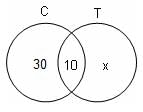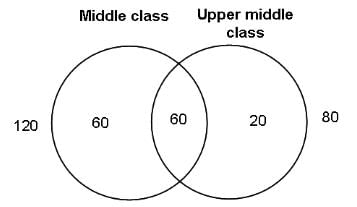Test Level 2: Set Theory - 1 (October 1) - CAT MCQ
10 Questions MCQ Test - Test Level 2: Set Theory - 1 (October 1)
A = {x : x is a perfect square; x ≤ 20; x ∈ N}
B = {y : y is not a perfect square; y ≤ 20; y ∈ N}
C = A ∪ B and D = A ∩ B
Which of the following statements is/are true?
(i) (C ∪ D) ∪ D = A ∪ B
(ii) C ∩ D = Ø
(iii) C ∪ D = C
B = {y : y is not a perfect square; y ≤ 20; y ∈ N}
C = A ∪ B and D = A ∩ B
(i) (C ∪ D) ∪ D = A ∪ B
(ii) C ∩ D = Ø
(iii) C ∪ D = C
In a locality, two-thirds of the people have Cable TV, one-fifth have VCR and one-tenth have both. What is the fraction of people having either Cable TV or VCR?
In a survey of 100 persons, it was found that 39 subscribed to TV Guide, 26 subscribed to Time and 6 subscribed to Scientific American. A total of 15 subscribed to at least two of these magazines and 2 subscribed to all the three. How many persons did not subscribe to any of the three?
Directions: Study the following information and answer the question.
In Foodpur, where a person has to eat either vegetarian food or non-vegetarian food, there are 600 people who eat non-vegetarian food, 400 people who eat vegetarian food and 150 people who eat both. Of the people who eat non-vegetarian, there are 300 who eat mutton, 400 who eat chicken and 200 who eat both these types of meat.
Q. How many people eat vegetarian food as well as mutton?
Directions: Study the following information and answer the question.
In Foodpur, where a person has to eat either vegetarian food or non-vegetarian food, there are 600 people who eat non-vegetarian food, 400 people who eat vegetarian food and 150 people who eat both. Of the people who eat non-vegetarian, there are 300 who eat mutton, 400 who eat chicken and 200 who eat both these types of meat.
Q. How many people do not eat chicken or mutton?
At a meeting of 100 people, there were 23 Indian men and 29 Indian women. Of these Indians, 4 were dentists and 24 were either men or dentists. Assume that there were no foreign dentists. How many women dentists attended the meeting?
If X = {4n - 3n - 1 : n ∈ N} and Y = {9(n - 1) : n ∈ N}, then X ∪ Y is equal to
In a group of 65 people, 40 like cricket, 10 like both cricket and tennis. Each one likes at least one sport out of cricket and tennis.
How many people like tennis?
At a dinner where 240 men are seated, half of the men belong to the middle class, one third to the upper-middle class and one-fourth to both the classes. How many men belong to neither class?





















